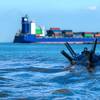By Edward Lundquist, Surface Warfare Magazine
As the first two Littoral Combat Ship (LCS) seaframes are taking shape, the first mission packages are being assembled and tested at the Naval Surface Warfare Center (NSWC) in Panama City, Fla.
LCS will be a reconfigurable, focused-mission ship that employs modular mission packages to counter anti-access threats in the littoral from mines, submarines and small, fast attack boats.
“It has a very focused mission in a particular operating environment against very specific threats,” said Capt. Walt Wright, program manager for LCS Mission Modules in the Navy’s Program Executive Office for Littoral and Mine Warfare.
“We’re bringing a large number of individual systems primarily focused on unmanned platforms -- unmanned underwater vehicles, unmanned surface vehicles [and] unmanned air vehicles -- in which we've integrated sensors and weapon systems. And we have put them together in a modularized fashion to put into the mission bays of the seaframe. We have a mission crew of only 15 people,” Wright said.
A mission package includes the mission systems, mission modules and mission crew. NSWC Panama City is designing, developing and integrating the systems for the mine warfare (MIW) mission package.
The antisubmarine warfare (ASW) package is being created by Space and Naval Warfare Systems Command (SPAWAR) in San Diego along with Naval Undersea Systems Center, Newport, R.I. The surface warfare (SUW) mission package is being developed by Naval Surface Warfare Center, Dahlgren, Va.
Lockheed Martin is building a semi-planing monohull design at Marinette Marine in Marinette, Wisc. General Dynamics is building a trimaran LCS at Austal in Mobile, Ala.
“We are creating the first of the three mission packages for LCS,” says Jose Velez, a systems engineer and the LCS customer advocate at NSWC Panama City. “Nobody’s ever done it before.”
NSWC Panama City is also the certifying authority for all of the mission packages. “We certify that the mission packages are ready. We check the interfaces, validate the communications and verify everything works the way it’s supposed to and that they are ready for fleet use,” Velez says.
The seaframe has the basic combat management system (CMS) with the computing environment and post mission analysis tools for each of the mission packages.
Each of the two ship designs, while very different, had to meet requirements for weight, volume, power, storage, and physical and computer interfaces, along with speed, draft and inherent self-defense capabilities.
The initial Flight 0 LCS employs “come as you are” offboard combat systems. These are systems that were in various stages of development prior to the LCS concept, and they were adapted for use on LCS. The two LCS seaframes employ different launch and recovery systems. In the future, the Navy hopes to develop a family of standard offboard systems optimized for use with LCS, with common launch and recovery systems, common command and control, and common communications.
The Navy is using “spiral development” in developing and testing mission packages.
“We don’t want to push these systems too fast. We’ll build a little, and test a little. We’ll get a capability into the fleet, and see how well it performs before trying to add more capability,” says Velez. “Then we can look at what other mission areas we want to address with LCS.”
The first team of Navy mission specialists has been identified and will begin training this spring at Panama City, working with the actual equipment.
Sponsored Content
Chris-Marine’s solutions help to prolong engine lifetime

Subscribe for
Maritime Reporter E-News
Maritime Reporter E-News is the maritime industry's largest circulation and most authoritative ENews Service, delivered to your Email five times per week









